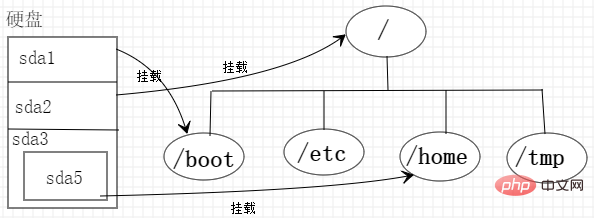
In Linux, mounting is to use a directory as an entry point and place the data of the disk partition in the directory. The directory of the entry point is called a mount point; simply put, a mount point It is the entry directory of the disk file system in Linux.

#The operating environment of this tutorial: linux5.9.8 system, Dell G3 computer.
All content in Linux is saved and managed in the form of files. Hardware devices are also files. This is completely different from Windows. Windows manages hardware through the device manager. Linux device files are saved in / In the dev/ directory, for example, the hard disk file is /dev/sd[a-p], the CD file is /dev/hdc, etc. The hardware device needs to be mounted to the corresponding directory file before it can be used.
The so-called mounting is to use a directory as an entry point and place the data of the disk partition in the directory, which means that the partition can be read by entering the directory. This action is called Mount, the directory of the entry point is called mount point.
Simply put: The mount point is actually the entry directory of the disk file system in Linux.
Since the most important thing in the entire Linux system is the root directory (/), the root directory must be mounted to a certain partition. As for other directories, they can be mounted to different partitions according to the user's own needs. Partition.
Common hardware device file names are as follows:
| Hardware | Device name |
|---|---|
| IDE hard disk | /dev/hd[a-d] |
| SCSI/SATA/USB hard disk | /dev/sd[ a-p] |
CD-ROM drive |
/dev/cdrom or /dev/sr0 |
| floppy disk | /dev/fd[01-1] |
| Printer (25-pin) | /dev/lp[0-2] |
| Printer (USB) | /dev/usb/lp[0-15] |
| Mouse | /dev/mouse |
Illustration:

As shown in the above figure, the hard disk is divided into three available partitions, of which sda1 and sda2 are respectively mounted as main partitions. Under the /boot and / directories, sda3 is an extended partition that contains a logical partition sda5, and sda5 is mounted in the /home directory. All data in the /boot directory is stored in the sda1 partition, all data in the /home directory is stored in the sda5 partition, and all data in the root directory / (except /boot and /home) is stored in the sda2 partition.
1.sda1 represents the first partition of the first hard disk, sda2 represents the second partition of the first hard disk, sdb1 represents a partition of the second hard disk, and so on...
2. The logical partition must start from sda5, because the file names of sda1, sda2, sda3 and sda4 are occupied by the primary partition or extended partition
Mount command
mount or mount -l
mount -a
mount [-t file system type] [-L volume label name] [-o special option] device file name mount point
Option
##umount device file name or umount mount point
| Description | |
|---|---|
| Update access time/noatime. When accessing a partition file, whether to update the access time of the file. The default is update | |
| Asynchronous/synchronous, the default is asynchronous | |
| Automatic/manual, when the mount –a command is executed, whether the contents of the /etc/fstab file will be automatically installed and mounted. The default is automatic | |
| Define the default value, which is equivalent to the seven options of rw, suid, dev, exec, auto, nouser, async | |
| Execute/not execute, set whether to allow execution of executable files in the file system, the default is exec to allow | |
| Remount has been mounted The loaded file system is generally used to specify special permissions for modification. Example: | mount -o remount,noexec /boot Remount the /boot partition and use noexec permissions
|
| Read and write/ Read-only, when the file system is mounted, whether it has read and write permissions, the default is rw | |
| with/without SUID permissions, set the file system Whether it has SUID and SGID permissions. The default is | |
| to allow/not allow ordinary users to mount. Set whether the file system allows ordinary users to mount. Mounting is not allowed by default. Only root can mount partitions | |
| Writing represents that the file system supports user disk quotas, which is not supported by default | |
| Writing represents that the file system supports group disk quotas, which are not supported by default |
Linux Video Tutorial》
The above is the detailed content of What is a linux mount point. For more information, please follow other related articles on the PHP Chinese website!